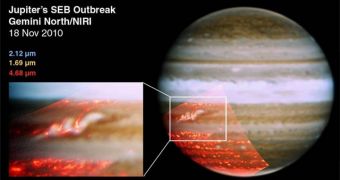A group of astronomers says that the planet Jupiter is finally looking like itself again, after having lost one of its dark brown stripe of clouds, called the South Equatorial Belt (SEB).
The atmospheric system is one of the two stripes of this nature the gas giant has, but it disappeared earlier this year under mysterious circumstances. It is now believed that the formation reappeared due to shift in the way cloud covers move above the planet's surface.
The SEB was confirmed to have reappeared on November 24, after Philippines amateur astronomer Christopher Go found it earlier this month, during a routine observations of the planet.
Upon hearing the news, research teams in the United States used the Infrared Telescope Facility (ITF), which is operated by NASA, and the Mauna Kea, Hawaii-based Gemini and Keck telescopes.
All follow-up studies were able to identify the equatorial belt manifesting itself at the same location it always did before last year. Apparently, the SEB has been developing since November 9, when it first reappeared as a white smudge on Jupiter's surface.
“This is a very textbook revival. It is following historic revival patterns. We are just seeing more of the details now,” Go tells Space in an email.
Astronomers now believe that the Equatorial Belt never fully disappeared per se. They say that it was most likely covered by an ammonia ice cloud deck, which was colored white, and therefore reflected a lot more light.
“The reason Jupiter seemed to 'lose' this band – camouflaging itself among the surrounding white bands – is that the usual downwelling winds that are dry and keep the region clear of clouds died down,” explains researcher Glenn Orton.
The scientist is based in Pasadena, California, at the NASA Jet Propulsion Laboratory (JPL). “One of the things we were looking for in the infrared was evidence that the darker material appearing in visible light was actually the start of clearing in the cloud deck, and that is precisely what we saw,” he adds.
This type of event takes place on Jupiter rather frequently, astronomers say. Once every few decades, one of its equatorial belts is completely covered by whit cloud banks, obscuring their study for one to three years, on average.
“At infrared wavelengths, images in reflected sunlight show that the spot is a tremendously energetic 'outburst,' a vigorous storm that reaches extreme high altitudes,” adds scientist Imke de Pater.
“The storms are surrounded by darker areas, bluish-gray in the visible, indicative of 'clearings' in the cloud deck,” adds the expert, who is a professor of astronomy at the University of California in Berkeley (UCB).
“These observations may help to unravel the mystery of why this transition occurs, and may allow us to understand the longevity of Jupiter's belt/zone structure,” concludes Oxford University scientist Leigh Fletcher.

 14 DAY TRIAL //
14 DAY TRIAL //